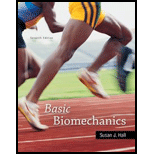
Basic Biomechanics
7th Edition
ISBN: 9780073522760
Author: Susan J Hall
Publisher: McGraw-Hill Education
expand_more
expand_more
format_list_bulleted
Concept explainers
Textbook Question
Chapter 1, Problem 10IP
A 0.5 kg ball is kicked with a force of 40 N. What is the resulting acceleration of the ball?
Expert Solution & Answer
Want to see the full answer?
Check out a sample textbook solution
Chapter 1 Solutions
Basic Biomechanics
Ch. 1 - Write a brief discussion about how knowledge of...Ch. 1 - Prob. 4IPCh. 1 - Write a summary list of the problem-solving steps...Ch. 1 - Prob. 6IPCh. 1 - Step by step, show how to arrive at a solution to...Ch. 1 - Solve for x in each of the equations below. Refer...Ch. 1 - Two schoolchildren race across a playground for a...Ch. 1 - A 0.5 kg ball is kicked with a force of 40 N. What...Ch. 1 - When attempting to balance your checkbook, you...Ch. 1 - Prob. 3AP
Ch. 1 - Wendell invests 10,000 in a stock portfolio made...Ch. 1 - The hypotenuse of right triangle ABC (shown here)...Ch. 1 - In triangle DEF, side E is 4 cm long and side F is...Ch. 1 - An orienteer runs 300 m north and then 400 m to...Ch. 1 - Prob. 8APCh. 1 - Prob. 9APCh. 1 - A sailboat heads north at 3 m/s for 1 hour and...
Knowledge Booster
Learn more about
Need a deep-dive on the concept behind this application? Look no further. Learn more about this topic, bioengineering and related others by exploring similar questions and additional content below.Similar questions
Recommended textbooks for you
 Principles Of Radiographic Imaging: An Art And A ...Health & NutritionISBN:9781337711067Author:Richard R. Carlton, Arlene M. Adler, Vesna BalacPublisher:Cengage Learning
Principles Of Radiographic Imaging: An Art And A ...Health & NutritionISBN:9781337711067Author:Richard R. Carlton, Arlene M. Adler, Vesna BalacPublisher:Cengage Learning Human Physiology: From Cells to Systems (MindTap ...BiologyISBN:9781285866932Author:Lauralee SherwoodPublisher:Cengage Learning
Human Physiology: From Cells to Systems (MindTap ...BiologyISBN:9781285866932Author:Lauralee SherwoodPublisher:Cengage Learning Fundamentals of Sectional Anatomy: An Imaging App...BiologyISBN:9781133960867Author:Denise L. LazoPublisher:Cengage Learning
Fundamentals of Sectional Anatomy: An Imaging App...BiologyISBN:9781133960867Author:Denise L. LazoPublisher:Cengage Learning



Principles Of Radiographic Imaging: An Art And A ...
Health & Nutrition
ISBN:9781337711067
Author:Richard R. Carlton, Arlene M. Adler, Vesna Balac
Publisher:Cengage Learning

Human Physiology: From Cells to Systems (MindTap ...
Biology
ISBN:9781285866932
Author:Lauralee Sherwood
Publisher:Cengage Learning


Fundamentals of Sectional Anatomy: An Imaging App...
Biology
ISBN:9781133960867
Author:Denise L. Lazo
Publisher:Cengage Learning
Chapter 7 - Human Movement Science; Author: Dr. Jeff Williams;https://www.youtube.com/watch?v=LlqElkn4PA4;License: Standard youtube license